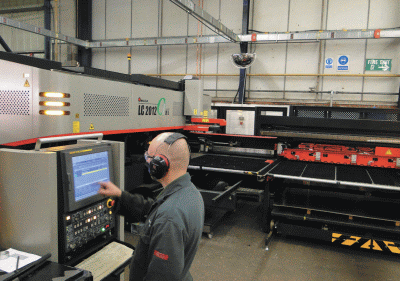 Amada UK has delivered a new LC2012 C1 punch-laser combination machine to the Plymouth headquarters of subcontract fabrication solutions specialist, Aldermans which is implementing a new strategy that includes provision of ongoing investment in the latest manufacturing technologies
Amada UK has delivered a new LC2012 C1 punch-laser combination machine to the Plymouth headquarters of subcontract fabrication solutions specialist, Aldermans which is implementing a new strategy that includes provision of ongoing investment in the latest manufacturing technologies
While Aldermans supplies to all industries, the company identifies four sectors that are key to revenue growth: transport/automotive, specialist furniture, industrial, and retail. This diverse manufacturing company supplies components and assemblies ranging from airport terminal furniture and car parts, through to electrical enclosure components and point-of-sale shop fittings, to name a few.
“After a tough recession the order book is now looking good and we are profitable once more, hence the decision to invest,” says the company’s operations manager, Rob Johns. “We have ambitions to become a national rather than regional player. At present, many of our customers are located within a 40 mile radius of Plymouth, but our investment programme will help address this issue.”
Aldermans was previously running two punch presses and a laser cutter, and while all had given first class service they had become a little “tired”.
“To outperform the competition and make our strategy become a reality we realised investment was the only way forward. As part of a lean manufacturing project we changed our entire factory layout, clearing out redundant equipment and reducing our inventory to improve efficiency. Replacing two machines with one made sense so we part-exchanged a punch press and laser cutter for an Amada LC2012 C1 punch-laser combination.”
The LC-C1 punch/laser combination machine is said to provide ultimate flexibility without compromise. An energy saving single AC servo drive motor provides 20 tonnes of variable punching stroke, while both the nozzle and lens offer quick-change laser technology. A 49-station punching turret is provided to accommodate even the most demanding of jobs.
It’s no secret punching is faster than laser cutting when it comes to the use of standard tooling to produce repeat features. For this reason, most manufacturers with combination machines punch as many features as possible to achieve better cost per part, while the laser is used for aesthetic profiling, or on apertures for which there is no tool.
“We’re a single shift operation but the flexibility of the automated Amada combination machine effectively makes us a three-shift, 24-hour facility because we can run unmanned, lights-out,” explains Johns. “Despite the reductions in cycle times and set-up times, and the improvement in accuracy, it’s the automation that provides us with the biggest benefits. In our business, quality and delivery are assumed – it is price that wins orders and the best way to drive prices down is through automation.”
The unmanned capability of the Amada LC2012 C1 is delivered thanks to an integrated part remover (PR-C1) for automatic picking and stacking of finished components. Additionally, Aldermans took an automatic load/unload system (MP-C1) to provide lights-out operation for sheet sizes up to 2,500 x 1,250 x 6mm (up to 3.3 tonnes of material can be accommodated). Labour allocated to the previous non-automated machines was redeployed – no jobs were lost.
Even greater levels of automation are provided by Amada’s Dr Abe Blank CAM software. This gives Aldermans automatic assignment of laser path/punch tooling, as well as automatic dissimilar part nesting and NC code generation. All programs are prepared offline and transferred to the machine via the Amada barcode reader and existing PC network.
“The Amada combination machine will make the supply of prototypes much more cost effective than before thanks to its flexibility,” says Johns. “As a company we openly seek quick-turnaround prototype work. In our experience, the supplier that makes the best job of prototypes is often rewarded with the contract.”
“The workforce was very buoyant when the investment was announced, and having now seen it first hand, everyone is convinced the company is looking forward to a prosperous future. It’s been a real confidence booster and the machine has already started earning its corn. One new job we picked up last year has now been transferred to the LC2012 C1. Previously we broke even on this job, now we make a profit.”
To underpin company growth, Johns says the plan for the future is further investment – possibly in 6-12 months’ time. “While we have plenty of direct competitors, few have punch-laser combination technology, and fewer still have a combination machine that is so well specified in terms of automation,” says Johns. “We see it as a real differentiator and hopefully, so will our customers.”


